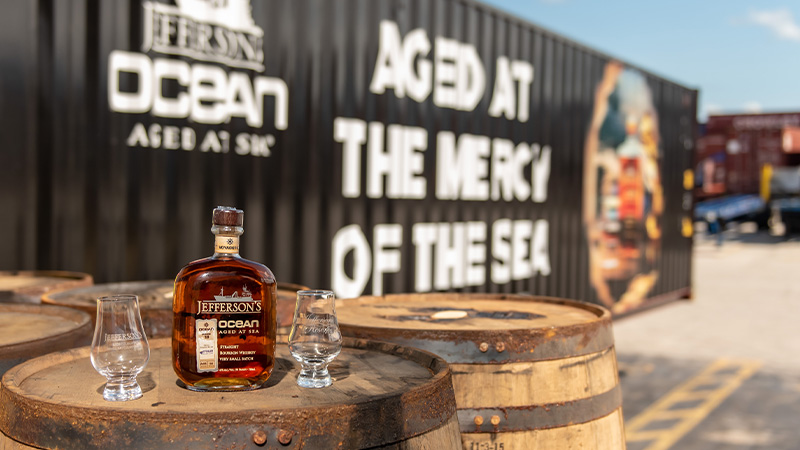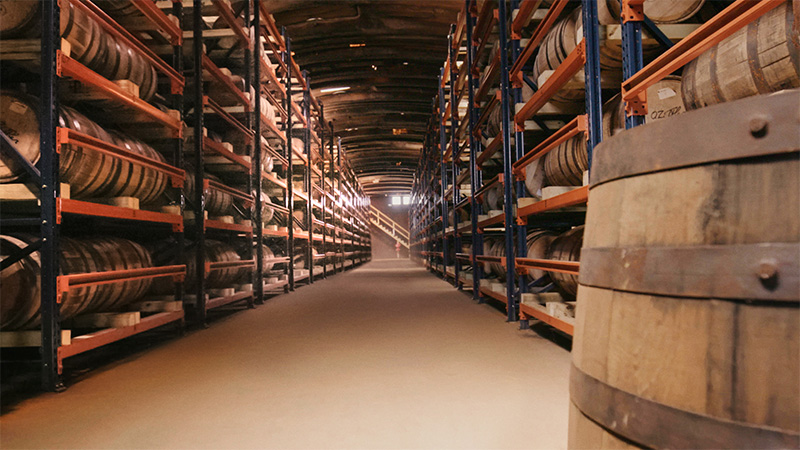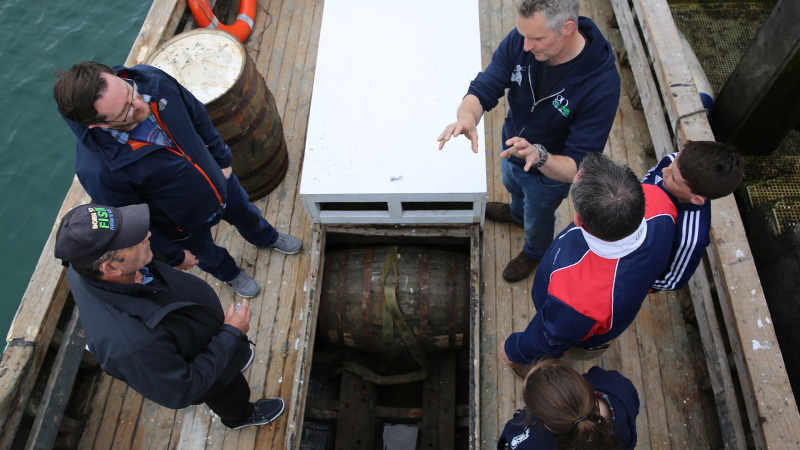Clare Island is best known for its medieval abbey, historic lighthouse, and castle that was once home to the legendary pirate queen Gráinne O’Malley. But the storm-tossed little isle, which guards the mouth of Clew Bay in County Mayo, Ireland, may soon develop a reputation for whiskey, uniquely aged in a former ferryboat moored in its harbor. The Dolphin, a 36-foot wooden-hulled vessel, was built in 1969, sank a few decades later, and was resurrected in 2015, followed by a two-year restoration by Carl O’Grady. His goal: repurpose the boat to make whiskey flavored by the island environment.
“I’m not trying to control anything; I want the natural effect,” says O’Grady, who gets his new-make single malt spirit from Connacht Whiskey Company on the mainland and ages it in the Dolphin for at least three years. Although Clare Island spirit meets European standards for whiskey, O’Grady cannot label it as “Irish whiskey” because the boat is not considered a bonded warehouse, a requirement for Ireland’s whiskey geographical indication (GI). Nevertheless, O’Grady says, the name isn’t important; it’s the end result of the aging process that matters.
“[It’s] effectively like a washing machine,” he explains. “There’s a hell of a lot more interaction between the liquid and the wood, obviously, because it’s constantly agitated.” That agitation, coupled with the fact that the barrels sit in the boat’s hold, which despite frequent pumping always has some seawater in it, creates amplified sweetness and a rich maritime note that O’Grady struggles to put into words. “It’s quite distinctive,” he says, adding that he has done comparisons with Connacht’s land-aged single malt of the same age. “It’s completely different.”
Don’t miss a drop!
Get the latest in beer, wine, and cocktail culture sent straight to your inbox.

Sea Changes
O’Grady isn’t the first to age whiskey on water. In fact, he was inspired by Jefferson’s Ocean Aged at Sea bourbon, which debuted in 2012. Maturing spirits at sea isn’t new at all, actually: For centuries, barrels of whiskey and other spirits moved from their place of distillation to market primarily via ship or boat, and still do. Nowadays, most of those spirits are already packaged by the time they’re loaded in, but that’s a recent development. Historically, they’d have been shipped in barrel — sometimes their only wood contact before being set out for sale.
Linie aquavit, which crosses the Equator twice in its maturation journey, is the longest-running spirits brand to market itself on the basis of maritime peregrinations, but these days it’s mainly whiskey makers who are employing the technique, noting that it can intensify flavors and texture from the oak. Jefferson’s founder, Trey Zoeller, who has run lab comparisons of bourbon aged in a traditional rickhouse versus its maritime counterpart, says there are three main things happening to Ocean bourbon.
First is increased contact with wood from the ship’s constant motion. “That constant contact with the wood brings out color, it brings out more flavor,” Zoeller says. It also increases the filtering effect of the charred oak, reducing the whiskey’s astringency. Second, he points to the “intense caramelization” of the barrels’ wood sugars that occurs inside their metal shipping container, especially as the vessel traverses the equator. “It’s like a hot box,” he explains, adding that the container’s interior can be 20 degrees warmer than the outside air. That caramelization adds not just flavor but weight, giving the bourbon more viscosity. Finally, salt air penetrates the barrel and adds saline notes to the whiskey, especially as liquid evaporates, which occurs at a higher rate than in Kentucky.
Though Jefferson’s Ocean barrels usually take the same four- to six-month journey through the Pacific and Atlantic Oceans, each batch varies depending on seasonal and weather conditions. “It was voyage 13 that we hit three named storms in the North Atlantic — three hurricanes — that just rocked the hell out of the bourbon,” Zoeller recalls. “Unfortunately for us, that caused a huge amount of evaporation so our yield was like 36 percent. But it really condensed it and made it extremely briny, so people go crazy for that voyage.”

In addition to ocean aging, Jefferson’s has offered Journey, a bourbon that traveled by boat from Louisville, Ky., to New Orleans, then around Florida and up the East Coast, eventually landing in New York City. The year-long experiment was meant to mimic the conditions under which bourbon was historically brought to market, via river flatboat, and replicate how it might have tasted back then.
Hank Ingram was also inspired by bourbon’s river connections, which struck a chord with his own family history. The sixth generation in the family behind Ingram Barge Company, which operates towboats and barges throughout the inland river system, Ingram spun a business school assignment into a full-fledged whiskey company whose focus is river-based maturation. In this case, barrels of new-make are loaded into a barge, arranged in traditional ricks, and left to age at the confluence of the Ohio and Mississippi Rivers in Ballard County, Ky.
“You get a lot of force from the river coming together right here at this point,” Ingram says. “It’s below all the dams so it’s all uncontrolled water, and as you can see from our hydrograph, it’s got a lot of variability in the way the river goes up and down.” That rise and fall, as well as wide diurnal temperature swings, increase contact between oak and spirit. “On the finish, we’re pulling out a lot more barrel notes,” Ingram says. “And the smoothness of the product has been quite phenomenal.”
Unfamiliar Waters
Maritime maturation is not always smooth sailing. It took Ingram three years to convince the Alcohol and Tobacco Tax and Trade Bureau (TTB) to license his barge as a bonded warehouse. Loading barrels in is like “dropping it in a bucket,” he says, and the barge’s enclosed design creates unique hazards. “The vapors that come out of the barrels, the angel’s share, are heavier than air,” Ingram explains. “So we have to remove those vapors from the bottom of the barge [using a system of fans and vents] or else we could have a very serious explosion risk.”
The salt air of the ocean can impart pleasing saline notes onto aging whiskey, but it also corrodes the iron hoops of the barrels. O’Grady says his wife, Barbara, a surfer, developed an organic wax to coat his casks’ hoops and prevent damage. Zoeller, meanwhile, has had the unpleasant experience of opening a container to find leaky — and sometimes empty — barrels, the damage going unrepaired during maturation as they aren’t monitored the way they would be in a warehouse.

Such risks are worth it for the flavors, and stories, that maritime aging yields. In the years since Jefferson’s debuted Ocean, other producers, like Kaiyo in Japan, Germany’s SILD, and even Maison Ferrand have embraced their own water-based maturation schemes, usually touting the unique characteristics that derive from months or years aboard a vessel that travels a particular route or is moored in a certain place. With increased interest in the provenance of whiskeys, such offerings provide another element of exploration for curious drinkers.
O’Grady is hoping that his whiskey will lead people to visit Clare Island and experience its special environment themselves. “It was never about creating the best whiskey in the world,” says O’Grady. “It was about creating something different and something that nobody else can replicate, because, Jesus, nobody else is mad enough to do what I’ve done.”
This story is a part of VP Pro, our free content platform and newsletter for the drinks industry, covering wine, beer, and liquor — and beyond. Sign up for VP Pro now!


